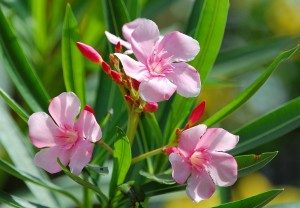Nerium oleander is an evergreen shrub or small tree in the dogbane family Apocynaceae, toxic in all its parts. It is the only species currently classified in the genus Nerium. It is most commonly known as oleander, from its superficial resemblance to the unrelated olive Olea. It is so widely cultivated that no precise region of origin has been identified, though southwest Asia has been suggested.
Contents
Uses
- Despite the danger, oleander seeds and leaves are used to make medicine. Oleander is used for heart conditions, asthma, epilepsy, cancer, painful menstrual periods, leprosy, malaria, ringworm, indigestion, and venereal disease; and to cause abortions.
A fixed combination of oleander leaf powdered extract, pheasant’s eye fluid extract, lily-of-the-valley fluid extract, and squill powdered extract has been used for treating mild heart failure.
Benefits
Oleander also works as a low-level toxicant to boost immune function in individuals in the following ways:
- Contains tremendous immune boosting action
- Inhibits angiogenesis
- Inhibits NF-kB factor in cancer cells
- Causes apoptosis in cancerous cells (natural cell death)
- Causes and increased rates of autophagic cancer cell death when tested on pancreatic cancer
Today, scientists are looking into the possible health benefits of heavily diluted oleander:
- Helping with muscle cramps
- Natural support for asthma, epilepsy and paralysis
- Help for skin conditions such as eczema
- Powerful all natural organic insecticide
- Usefulness in aiding heart conditions
- Natural support for healthy blood sugar levels
- Possible support for the HIV virus
- Usefulness in increasing healing times for wounds, when crushed and applied topically
- Powerful immune-system stimulator
- Promoting normal menstrual cycles
- Aiding the body in the fight against arthritis, psoriasis & hepatitis C
Cautions
- While oleander may possess many healing properties, much like many powerful botanical remedies, this plant can also be deadly when taken or prepared incorrectly. This plant should never be eaten raw, as its raw extract form is highly toxic. One raw leaf has enough poison in it to kill a small child, as well as any pet
Interactions
- None are recorded.
Other names
Adelfa, Baladre, Cascabela thevetia, Cerbera thevetia, Common Oleander, Exile Tree, Huang Hua Jia, Jia Zhu Tao, Kaner, Karvir, Karvira, Laurel Rosa, Laurier-Rose, Laurier Rose, Laurose, Nérier à Feuilles de Laurier, Nérion, Nerium indicum, Nerium Oleander, Nerium odorum, Oleanderblatter, Oléandre, Oleandri Folium, Rose Bay, Rose Laurel, Sweet Scented Oleander, Thevetia neriifolia, Thevetia peruviana, Yellow Oleander
References
Source: GlobalHealingCenter, http://www.globalhealingcenter.com/natural-health/oleander/

